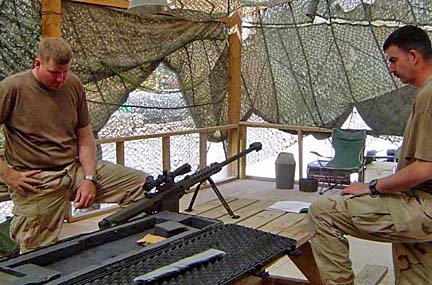

|
BOMB SQUAD
A Schofield unit spends six months
cleaning up ordnance in Afghanistan
During his recent six-month deployment to Afghanistan, Army bomb squad expert Jody George came across a sight that still haunts him today -- a suicide bomber who had killed himself by exploding one charge but still had explosives and a live connection wrapped around his neck.
"It was something I would have never expected," said Staff Sgt. George, who had to dismantle the bomb. "It was rigged to kill soldiers."
George was one of 20 Schofield Barracks soldiers belonging to the 706th Explosive Ordnance Company, which returned to Wahiawa on July 13.
Capt. Steve Elder, commander of the 706th, said the unit destroyed 150 tons of explosives on 550 missions while supporting the 10th Mountain Division and later the 25th Infantry Division's 3rd Brigade when it arrived in Afghanistan in March.
"The 706th is the only unit of its kind assigned to United States Army Pacific, and their missions in Afghanistan ranged from dismantling improvised explosive devices to interdicting pre-positioned rocket attacks," said Elder, who has been an explosive ordnance disposal expert for the past five years.
"Every soldier that deployed to Afghanistan returned to Hawaii. No accidents or casualties, all appendages attached," said Elder, whose unit worked out of Kandahar in southern Afghanistan.

|
"We worked in teams of two and covered five to six forward operating bases. Afghanistan is littered with all types of explosives because of all the fighting that has occurred there, beginning with the Russians. The Taliban also stored caches of rockets and mortars, some wrapped in plastic, to be retrieved at a later date.
"Afghanistan, I've been told, is the most heavily mined places in the world, thanks to our Russian friends."
One of the largest weapons caches, Elder said, was found at an Afghan Militia Force compound in Qalat, where there were at least 6,000 rockets and scores of mortars, land mines, fuses, hand grenades and artillery shells scattered through out the area.
"We just blew up those ordnances which could be rigged and used as an IED (improvised explosive device)," Elder added. "The rest was secured and will be destroyed at a commercial company."
Army Pfc. Amy Brownell, 20, was one of the youngest members of the company.
"The first couple of times going outside of the wire (leaving base camp) was unnerving," said Brownell, who has been in the Army for 18 months. "It was nerve wracking. You didn't know what to expect. I never got complacent."
Although Brownell's main duty in the unit was to handle administrative matters, she did pull convoy security duty and visited the demolition range where the confiscated weapons were exploded.
"It was a different learning experience," Brownell added. "It was a pretty busy and very intense time."
Ordnance disposal experts for all the services attend the same school at Eglin Air Force Base in Florida for a year.
"All the initial training is the same," Elder said, "but each service has a specific mission. For the Army it's ground (ordnances). The Navy emphasizes underwater demolition, and for the Air Force it's missiles.
"The time you really learn is when you report to your unit and you have hands-on training."
George said, however, that deployment to places like Afghanistan are far more valuable "because it gives us real-world experiences."
"We train with plastic pieces we call 'rubber duckies,' but it's no substitute for the real thing," George said. "What occurs on the battlefield can't be reproduced. A deployment like this is beneficial to everyone, from the most senior to the most junior soldiers."
When the unit left Hickam Air Force Base on Jan. 12, it loaded all its equipment and seven Humvees on the two C-17 Air Force jet cargo transports and flew to Kandahar with a stop in Germany.
Elder said the mission of the Schofield Barracks unit is to respond to problems with conventional, nuclear, biological and chemical ordnance throughout the Pacific Rim.
"That means everything from here to Japan," Elder said.
The Army unit also provides support to the U.S. Secret Service, the U.S. State Department, the president and vice president and local law enforcement officials.
Over the past several years, George said his unit has responded to calls by local police where people have turned in war souvenirs.
There also were incidents on the Big Island where a pipe bomb was found at a school and another explosive device was discovered at a construction site strapped to equipment.
— ADVERTISEMENTS —
— ADVERTISEMENTS —